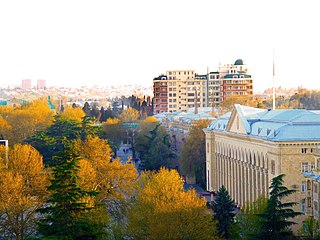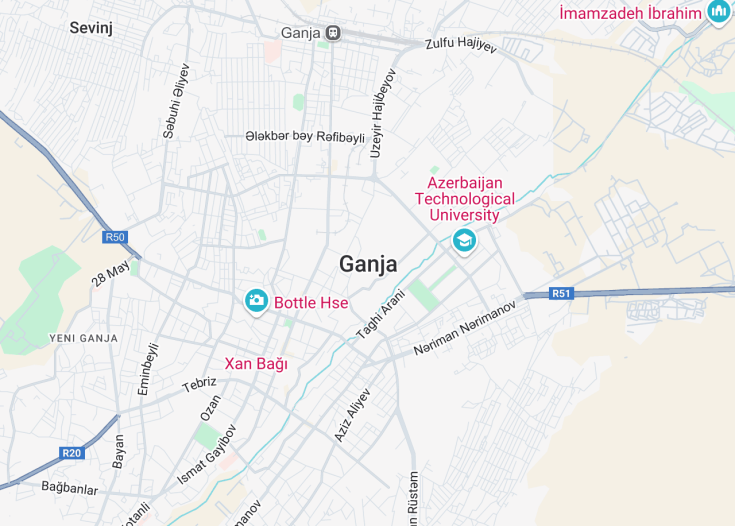Ganja, Azerbaijan’s second-largest city, boasts a rich tapestry of history and culture, making it a fascinating destination for travelers. With its roots stretching back over 2,500 years, Ganja offers a unique blend of ancient and modern attractions, including medieval architecture, lush parks, and vibrant street life. The city’s diverse cultural heritage, influenced by various civilizations, is evident in its music, art, and culinary offerings, promising a comprehensive cultural immersion for visitors.
Do not miss visiting the Nizami Ganjavi Mausoleum, a tribute to the 12th-century poet. Exploring this historic site offers deep insight into Azerbaijan’s literary legacy.
Ensure to visit Ganja at the time of national festivities to experience local life at its most vibrant and gain a deeper appreciation of Azeri traditions and communal spirit.
Ganja: The Gateway to Azerbaijan’s Rich Heritage
| Country | Azerbaijan |
| Time in Ganja | GMT+4 |
| Language spoken | Azerbaijani |
| Population | 338,700 (source: latest census data) |
| Currency | Azerbaijani Manat (₼, AZN) |
| Airports |
|
Framed by the stunning Lesser Caucasus mountains, Ganja proudly stands as Azerbaijan’s second-largest city. With its origin tracing back more than a thousand years, Ganja boasts a fascinating blend of ancient traditions and vibrant modern can influence. The city has historically served as an important cultural and economic center in the region, precisely located along the Silk Road which contributed to its wealth and diversity through the centuries.
Known for landmark historical sites, Ganja offers a unique window into the past of not just Azerbaijan but the broader South Caucasus region. Sites like the Nizami Ganjavi Mausoleum celebrate the legendary 12th-century poet after whom the city is informally known. Its religious architecture is another draw, with mosques showcasing exquisite Islamic art and craftsmanship, and the ancient Christian church displaying intricate stone carvings.
Modern-day Ganja is just as exciting with its bustling bazaars, expansive green spaces, and well-maintained parks where locals often gather for picnics and leisure activities. The city also serves as a hub for local wine production, featuring vineyards that offer tours and tastings that help promote cultural tourism. Locals are particularly proud of their culinary heritage, and Ganja is famous within Azerbaijan for dishes like kebabs and plov, which visitors can explore in the many traditional eateries throughout the city.
Each year, Ganja sees a variety of cultural festivals that reinforce its status as a cultural monument in Azerbaijan. With a burgeoning arts scene, theaters, museums, and galleries, the city offers plenty of cultural enrichment, making it a fulcrum of creative expression and historical preservation in modern Azerbaijan.
Where is Ganja?
Ganja is located in the western part of Azerbaijan, nestled among the foothills of the Lesser Caucasus mountains.
Distances:
| Route | Distance by car | Time by car |
|---|---|---|
| Baku to Ganja | 228 miles (367 km) | Approx. 5 hours |
| Tbilisi to Ganja | 160 miles (257 km) | Approx. 4 hours |
What is Ganja famous for?
Ganja is renowned for its rich historical background, ancient architecture, and being the birthplace of the famous poet, Nizami Ganjavi. Its vibrant culture and beautiful green landscapes make it a must-visit city in Azerbaijan.
History
Ancient Origins
Ganja, one of Azerbaijan’s oldest cities, boasts a rich history that dates back several millennia. Archeological findings suggest that the area was inhabited in prehistoric times, with settlements dating as far back as the 5th century BC. Ganja’s strategic location along important trade routes contributed to its early development and significance.
Medieval Era (8th-15th Centuries)
During the medieval period, Ganja emerged as a significant urban center within the Caucasian region. It was initially part of the Persian Empire and later integrated into various Islamic caliphates. The city was renowned for its craftsmen and traders, and it became a melting pot of diverse cultures and religions, which enriched its cultural tapestry. In the 12th century, it was renamed Ganja after being rebuilt by the Seljuq Turks and flourished as a cultural and economic hub.
The Russian Empire (19th-20th Centuries)
The early 19th century marked a pivotal change when Ganja fell under Russian control after the Russo-Persian War. The city underwent significant changes as it integrated into the Russian Empire, including infrastructural developments and an influx of Russian settlers, which further diversified its demographic composition. During this period, Ganja evolved into a modern city with the establishment of new educational institutions and industries.
Modern Era (20th Century – Present)
In the 20th century, Ganja witnessed major transformations with its integration into the Soviet Union, which brought industrialization and modernization. Post-Soviet independence in 1991 marked the beginning of a new era for Ganja as it became part of the newly independent Azerbaijan. Today, the city is a vibrant blend of its ancient heritage and modern Azerbaijani culture, continuing to thrive as a major cultural and economic center in the region.
Visit Ganja
What to see and do in Ganja
Ganja offers a multitude of attractions that cater to a wide range of interests. One must not miss the iconic Nizami Mausoleum, dedicated to the 12th-century poet Nizami Ganjavi, which showcases stunning architecture. For nature lovers, Lake Goygol, formed by an earthquake in the 12th century, provides breathtaking scenery and a peaceful retreat. History enthusiasts will appreciate the Ganja Gate, remnants of the ancient city walls that testify to the city’s historical significance.
- Explore the ancient Ganja Gate
- Visit the Nizami Mausoleum
- Relax by Lake Goygol
Festivals and Events in Ganja
Ganja’s cultural calendar is dotted with various events and festivals, particularly vibrant during the spring and autumn months. The Ganja International Music Festival, held annually, attracts musicians and enthusiasts from across the region and beyond, promoting a rich exchange of musical traditions. Another significant event is the Novruz Bayram, celebrating the Persian New Year, where the city comes alive with folk music, dance, and traditional foods.
Best time to visit Ganja
The best times to visit Ganja are during the spring (March to May) and autumn (September to November). These seasons offer pleasant weather, conducive to exploring the outdoor sites and participating in the various cultural festivities that the city hosts.
Is Ganja worth visiting?
Ganja is undoubtedly worth visiting for its unique blend of history, culture, and natural beauty. The city offers a rare glimpse into the ancient and modern dynamics of Azerbaijan and presents a less trodden, authentic experience compared to the more tourist-heavy Baku. Whether it’s exploring its ancient sites, enjoying its natural landscapes, or immersing in its vibrant cultural life, Ganja promises a rich and rewarding travel experience.









